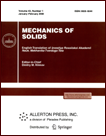 | | Mechanics of Solids
A Journal of Russian Academy of Sciences | | Founded
in January 1966
Issued 6 times a year
Print ISSN 0025-6544
Online ISSN 1934-7936 |
Archive of Issues
| Total articles in the database: | | 13362 |
| In Russian (Èçâ. ÐÀÍ. ÌÒÒ): | | 8178
|
| In English (Mech. Solids): | | 5184 |
|
| << Previous article | Volume 60, Issue 1 / 2025 | Next article >> |
| Prajjwal Parmar, Saroj Mandal, and Smita Pal Sarkar, "Effect of Moving Heat Source within the Framework of Two-Temperature Higher Order Lagging Phenomena in Human Skin Tissue," Mech. Solids. 60 (1), 261-277 (2025) |
| Year |
2025 |
Volume |
60 |
Number |
1 |
Pages |
261-277 |
| DOI |
10.1134/S0025654424606177 |
| Title |
Effect of Moving Heat Source within the Framework of Two-Temperature Higher Order Lagging Phenomena in Human Skin Tissue |
| Author(s) |
Prajjwal Parmar (Department of Mathematics, Indian Institute of Engineering Science and Technology, Shibpur, Howrah, West Bengal, 711103 India, prajjwalparmar77@gmail.com)
Saroj Mandal (Department of Mathematics, Sitananda College, Nandigram, West Bengal, 721631 India, srj86mail@gmail.com)
Smita Pal Sarkar (Department of Mathematics, Indian Institute of Engineering Science and Technology, Shibpur, Howrah, West Bengal, 711103 India, smitasarkar.math@faculty.iiests.ac.in) |
| Abstract |
The investigation and comprehension of heat transport, encompassing variations in thermophysical variables such as thermodynamic and conductive temperatures, strain, displacement, and
stress within biological tissues and organs, hold crucial importance in medical thermal therapeutic
applications, such as the treatment by hyperthermia and thermal ablation. This study analyzes the
effect of moving heat source with constant velocity on a finite-length skin tissue using the Pennes heat
conduction equation within the framework of the two-temperature theory. The Modified-Green-Lindsay model, incorporating thermal relaxation and strain-temperature rate effects, is employed
alongside comparisons with the Green-Lindsay and Lord-Shulman models. Constitutive relations
and governing equations are formulated, with solutions obtained in the Laplace transformed domain
and estimated numerically via the Honig Hirdes algorithm. The results, presented graphically, demonstrate the significant influence of the two-temperature parameter and heat source velocity on the field
variables, offering valuable insights into thermoelastic behavior in medical applications. |
| Keywords |
bio-heat transfer, Modified-Green-Lindsay model, two-temperature parameter, skin tissue |
| Received |
05 November 2024 | Revised |
05 January 2025 | Accepted |
06 January 2025 |
| Link to Fulltext |
|
| << Previous article | Volume 60, Issue 1 / 2025 | Next article >> |
|
 If you find a misprint on a webpage, please help us correct it promptly - just highlight and press Ctrl+Enter If you find a misprint on a webpage, please help us correct it promptly - just highlight and press Ctrl+Enter
|
|

 Russian
Russian  English
English